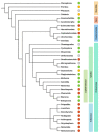Novel Approach Combining Transcriptional and Evolutionary Signatures to Identify New Multiciliation Genes
- PMID: 34573434
- PMCID: PMC8470418
- DOI: 10.3390/genes12091452
Novel Approach Combining Transcriptional and Evolutionary Signatures to Identify New Multiciliation Genes
Abstract
Multiciliogenesis is a complex process that allows the generation of hundreds of motile cilia on the surface of specialized cells, to create fluid flow across epithelial surfaces. Dysfunction of human multiciliated cells is associated with diseases of the brain, airway and reproductive tracts. Despite recent efforts to characterize the transcriptional events responsible for the differentiation of multiciliated cells, a lot of actors remain to be identified. In this work, we capitalize on the ever-growing quantity of high-throughput data to search for new candidate genes involved in multiciliation. After performing a large-scale screening using 10 transcriptomics datasets dedicated to multiciliation, we established a specific evolutionary signature involving Otomorpha fish to use as a criterion to select the most likely targets. Combining both approaches highlighted a list of 114 potential multiciliated candidates. We characterized these genes first by generating protein interaction networks, which showed various clusters of ciliated and multiciliated genes, and then by computing phylogenetic profiles. In the end, we selected 11 poorly characterized genes that seem like particularly promising multiciliated candidates. By combining functional and comparative genomics methods, we developed a novel type of approach to study biological processes and identify new promising candidates linked to that process.
Keywords: comparative genomics; evolution; functional genomics; multi-omics data integration; multiciliation; rare diseases.
Conflict of interest statement
The authors declare no conflict of interest. The funders had no role in the design of the study; in the collection, analyses, or interpretation of data; in the writing of the manuscript, or in the decision to publish the results.
Figures








References
Publication types
MeSH terms
Substances
LinkOut - more resources
Full Text Sources

